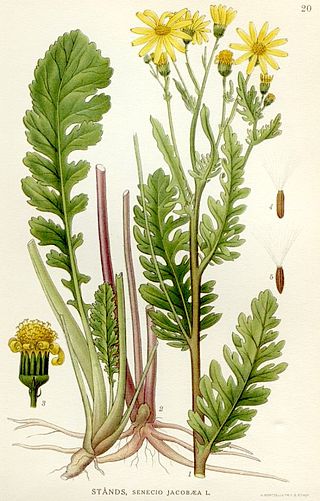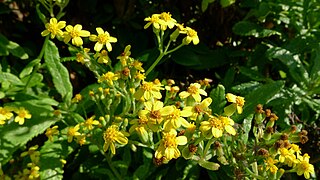
Jacobaea vulgaris, syn. Senecio jacobaea, is a very common wild flower in the family Asteraceae that is native to northern Eurasia, usually in dry, open places, and has also been widely distributed as a weed elsewhere.

Senecio vulgaris, often known by the common names groundsel and old-man-in-the-spring, is a flowering plant in the family Asteraceae. It is an annual herb, native to the Palaearctic and widely naturalised as a ruderal species in suitable disturbed habitats worldwide.

Echium plantagineum, commonly known as purple viper's-bugloss or Patterson's curse, is a species of the genus Echium native to western and southern Europe, northern Africa, and southwestern Asia. It has also been introduced to Australia, South Africa, and United States, where it is an invasive weed. Due to a high concentration of pyrrolizidine alkaloids, it is poisonous to grazing livestock, especially those with simple digestive systems, such as horses.

Heliotropium is a genus of flowering plants traditionally included in the family Boraginaceae s.l., but placed in the family Heliotropiaceae within the Boraginales order, by the Boraginales Working Group.. There are around 325 species in this almost cosmopolitan genus, which are commonly known as heliotropes. They are highly toxic to dogs and cats, as well as to humans.

Pyrrolizidine alkaloids (PAs), sometimes referred to as necine bases, are a group of naturally occurring alkaloids based on the structure of pyrrolizidine. Their use dates back centuries and is intertwined with the discovery, understanding, and eventual recognition of their toxicity on humans and animals.
Hepatic veno-occlusive disease (VOD) or veno-occlusive disease with immunodeficiency is a potentially life-threatening condition in which some of the small veins in the liver are obstructed. It is a complication of high-dose chemotherapy given before a bone marrow transplant and/or excessive exposure to hepatotoxic pyrrolizidine alkaloids. It is classically marked by weight gain due to fluid retention, increased liver size, and raised levels of bilirubin in the blood. The name sinusoidal obstruction syndrome (SOS) is preferred if hepatic veno-occlusive disease happens as a result of chemotherapy or bone marrow transplantation.

Senecio flaccidus, formerly recorded as Senecio douglasii, member of the daisy family and genus Senecio also known as threadleaf ragwort, is a native of the southwestern Great Plains of North America.

Senecio angulatus, also known as creeping groundsel and Cape ivy, is a succulent flowering plant in the family Asteraceae that is native to South Africa. Cape ivy is a scrambling herb that can become an aggressive weed once established, making it an invasive species. It is grown as an ornamental plant for its satiny foliage and sweet-scented flowers.

Dichapetalum cymosum, commonly known as gifblaar from Afrikaans, or occasionally by its English translation, poison leaf, is a small prostrate shrub occurring in northern parts of Southern Africa in the family Dichapetalaceae. It is notable as a common cause of lethal cattle poisoning in this region and is considered one of the 'big 6' toxic plants of cattle in South Africa. A 1996 estimate of plant poisonings in South Africa attributes 8% of cattle mortality caused by poisonous plants to it. The majority (70%) of fatal cases are in Limpopo province, with 10% each in North West, Mpumalanga, and Gauteng. Fluoroacetate, the poison used to synthetically produce Compound 1080 used extensively in New Zealand, occurs in all parts of the plant and is responsible for the toxic effects shown.

Senecio madagascariensis, also known as Madagascar ragwort, is a species of the genus Senecio and family Asteraceae that is native to Southern Africa. Other common names include Madagascar groundsel and fireweed. It has been included on the noxious weeds list for Hawaii and the reject list for Australia. S.madagascariensis is the diploid cytotype of S.inaequidens.
The Faculty of Veterinary Science is a faculty of the University of Pretoria. Founded in 1920, it is the second oldest veterinary faculty in Africa. With the exception of the faculties in Khartoum, and Cairo, all the other African faculties were established after 1960. It is the only one of its kind in South Africa and is one of 33 veterinary faculties in Africa.

Conium maculatum, known as hemlock, or poison hemlock is a highly poisonous flowering plant in the carrot family Apiaceae, native to Europe and North Africa. It is herbaceous without woody parts and has a biennial lifecycle. A hardy plant capable of living in a variety of environments, hemlock is widely naturalised in locations outside its native range, such as parts of Australia, West Asia, and North and South America, to which it has been introduced. It is capable of spreading and thereby becoming an invasive weed.

Senecionine is a toxic pyrrolizidine alkaloid isolated from various botanical sources. It takes its name from the Senecio genus and is produced by many different plants in that genus, including Jacobaea vulgaris. It has also been isolated from several other plants, including Brachyglottis repanda, Emilia, Erechtites hieraciifolius, Petasites, Syneilesis, Crotalaria, Caltha leptosepala, and Castilleja.
Pyrrolizidine alkaloidosis is a disease caused by chronic poisoning found in humans and other animals caused by ingesting poisonous plants which contain the natural chemical compounds known as pyrrolizidine alkaloids. Pyrrolizidine alkaloidosis can result in damage to the liver, kidneys, heart, brain, smooth muscles, lungs, DNA, lesions all over the body, and could be a potential cause of cancer. Pyrrolizidine alkaloidosis is known by many other names such as "Pictou Disease" in Canada and "Winton Disease" in New Zealand. Cereal crops and forage crops can sometimes become polluted with pyrrolizidine-containing seeds, resulting in the alkaloids contaminating flour and other foods, including milk from cows feeding on these plants.

Riddelliine is a chemical compound classified as a pyrrolizidine alkaloid. It was first isolated from Senecio riddellii and is also found in a variety of plants including Jacobaea vulgaris, Senecio vulgaris, and others plants in the genus Senecio.

Senecio hispidulus, the hill fireweed or rough groundsel, is a species of flowering plant in the daisy family. It is found in many parts of Australia.
Amphistomiasis is a parasitic disease of livestock animals, more commonly of cattle and sheep, and humans caused by immature helminthic flatworms belonging to the order Echinostomida. The term amphistomiasis is used for broader connotation implying the disease inflicted by members of Echinostomida including the family Paramphistomidae/Gastrodiscidae ; whereas paramphistomiasis is restricted to that of the members of the family Paramphistomidae only. G. discoides and Watsonius watsoni are responsible for the disease in humans, while most paramphistomes are responsible in livestock animals, and some wild mammals. In livestock industry the disease causes heavy economic backlashes due to poor production of milk, meat and wool.

Gloriosa superba is a species of flowering plant in the family Colchicaceae. Common names include flame lily, climbing lily, creeping lily, glory lily, gloriosa lily, tiger claw, and fire lily.

Senecio ruwenzoriensis is an African species of plant. While it is widely distributed, it seems to be highly localised in this range.

Lantadenes are naturally occurring pentacyclic triterpenoids found in the Lantana camara plant. They are known to be poisonous to livestock that graze on the leaves of the plant, causing photosensitivity and hepatotoxicity as major symptoms. Lantadenes A and B are the most abundant and bioactive triterpenoids found in the Lantana camara leaves.



















